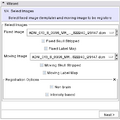Difference between revisions of "2010 Summer Project Week HAMMER: Deformable Registration"
From NAMIC Wiki
(Created page with '__NOTOC__ <gallery> Image:HammerAttribute.jpg|Components of Hammer Attribute Vectors. Image:HammerSimilarity.png|Similarity map (middle column) computed on moving image (right) f…') |
|||
| (10 intermediate revisions by 2 users not shown) | |||
| Line 2: | Line 2: | ||
<gallery> | <gallery> | ||
Image:HammerAttribute.jpg|Components of Hammer Attribute Vectors. | Image:HammerAttribute.jpg|Components of Hammer Attribute Vectors. | ||
| − | Image:HammerSimilarity.png|Similarity map | + | Image:HammerSimilarity.png|Similarity map |
Image: namic.png|The output deformation filed by HAMMER | Image: namic.png|The output deformation filed by HAMMER | ||
| − | Image: | + | Image: b1.png|Hierarchical Registration |
| + | Image: b3.png|Processing pipeline in Slicer3 | ||
| + | Image: b2.png|Warping result by HAMMER | ||
| + | Image: HammerWizard-Step1.png|HammerWizard1 | ||
| + | Image: HammerWizard-Step2.png|HammerWizard2 | ||
</gallery> | </gallery> | ||
| Line 29: | Line 33: | ||
<h3>Progress</h3> | <h3>Progress</h3> | ||
| − | * | + | * Project week (Boston, 2010): We have 1) extended HAMMER registration algorithm to work on intensity image, bypassing the pre-segment of MR images; 2) replacing the gaussian propagation with the thin-plate interpolation to achieve more accurate and efficient registration; 3) implement the soft-assignment strategy, instead of the one-to-one correspondence, in detecting correspondence during registration. |
| − | * | + | * Project week (Utah, 2010): We have finalized HAMMER "alpha" release on NITRC and gave a tutorial. In the next couple of weeks, we will continue to polish the tutorial and code, provide support to and collect feedback from early HAMMER adapters. |
| + | |||
| + | * Project week 2009 in Utah: we have developed/implemented HAMMER registration algorithm using ITK classes. New ITK classes have been created for tasks of HAMMER. Each component has been tested. The source code is version controlled at NITRC site. The current development corresponds to the original Hammer algorithm that is based on tissue classification of T1 weighted images (as outlined on the first HAMMER paper). | ||
</div> | </div> | ||
| Line 40: | Line 46: | ||
| − | |||
| − | |||
| − | |||
</div> | </div> | ||
==References== | ==References== | ||
* Dinggang Shen, Christos Davatzikos, [http://www.med.unc.edu/~dgshen/papers/Hammer_VersionInTMI.pdf HAMMER: Hierarchical Attribute Matching Mechanism for Elastic Registration], IEEE Trans. on Medical Imaging, 21(11):1421-1439, Nov 2002. | * Dinggang Shen, Christos Davatzikos, [http://www.med.unc.edu/~dgshen/papers/Hammer_VersionInTMI.pdf HAMMER: Hierarchical Attribute Matching Mechanism for Elastic Registration], IEEE Trans. on Medical Imaging, 21(11):1421-1439, Nov 2002. | ||
Latest revision as of 13:50, 25 June 2010
Home < 2010 Summer Project Week HAMMER: Deformable RegistrationKey Investigators
- UNC: Guorong Wu, Dinggang Shen
- GE : Xiaodong Tao, Jim Miller
Objective
We will continue developping and testing HAMMER registration algorithm implemented using ITK. The goal is to have an initial version ready by the end of the week that can be distributed within NA-MIC community for more extensive testing.
Approach, Plan
We will develop a Slicer module for the current implementation of the Hammer registration algorithm and test on images from multiple sources to make the algorithm robust and easy to use. Base line results and test will be generated.
Progress
- Project week (Boston, 2010): We have 1) extended HAMMER registration algorithm to work on intensity image, bypassing the pre-segment of MR images; 2) replacing the gaussian propagation with the thin-plate interpolation to achieve more accurate and efficient registration; 3) implement the soft-assignment strategy, instead of the one-to-one correspondence, in detecting correspondence during registration.
- Project week (Utah, 2010): We have finalized HAMMER "alpha" release on NITRC and gave a tutorial. In the next couple of weeks, we will continue to polish the tutorial and code, provide support to and collect feedback from early HAMMER adapters.
- Project week 2009 in Utah: we have developed/implemented HAMMER registration algorithm using ITK classes. New ITK classes have been created for tasks of HAMMER. Each component has been tested. The source code is version controlled at NITRC site. The current development corresponds to the original Hammer algorithm that is based on tissue classification of T1 weighted images (as outlined on the first HAMMER paper).
References
- Dinggang Shen, Christos Davatzikos, HAMMER: Hierarchical Attribute Matching Mechanism for Elastic Registration, IEEE Trans. on Medical Imaging, 21(11):1421-1439, Nov 2002.





